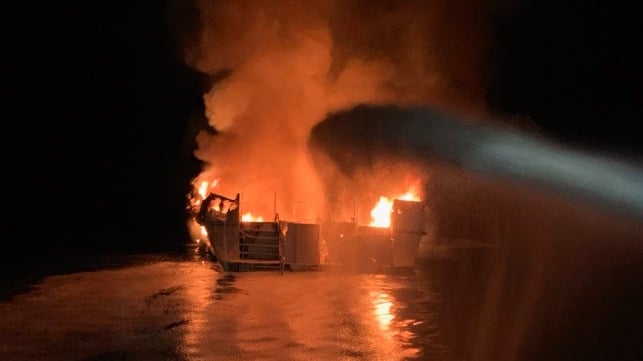NTSB: Management Failures Led to Deadly Dive Boat Fire

The National Transportation Safety Board has concluded its investigation into the fire aboard the dive boat Conception, which burned and sank off Santa Cruz Island on September 2, 2019. 33 passengers and one crewmember died in the fire, making it one of America's most deadly maritime casualties in decades.
NTSB did not reach a conclusion on the initial source of the fire, but it noted evidence suggesting that the likely cause could have been "the electrical distribution system of the vessel, unattended batteries being charged, improperly discarded smoking materials, or another undetermined ignition source." Previous passengers aboard the Conception and other Truth Aquatics boats testified that a wide range of powerful battery-operated equipment - cameras, dive lights, underwater scooters and other paraphenalia - would be charged inside the salon or the galley each night. A battery-related fire broke out previously aboard one of Conception's sister ships, but it was extinguished quickly by a passenger.
Regardless of ignition source, NTSB suggested that the probable cause of the casualty was "the failure of Truth Aquatics, Inc., the owner and operator of Conception, to provide effective oversight of its vessel and crewmember operations." In particular, NTSB alleged that Truth Aquatics lacked effective company-wide requirement for maintaining a roving night watch while at anchor, as required by federal regulations for a Subchapter T boat. In multiple witness interviews, former crewmembers told NTSB investigators that they did not recall a designated watch or roving patrol on board the Conception on prior voyages. The captain of another vessel in operator Truth Aquatics' fleet, the Vision, told NTSB that he believed that having one crewmember sleep in the same compartment as the passengers "somehow fulfilled" the federal requirement for a roving watch.
Additionally, NTSB pointed to flaws in the (compliant) design of Conception's escape hatch for her lower berthing area, the compartment where all of the victims were located at the time of the fire. A small escape hatch above a bunk bed led up directly into the salon area - the same compartment accessed by the berthing area's ladderway. When the fire broke out in Conception's salon, both points of egress would have led the victims towards the blaze.
The Board also pointed to the (compliant) lack of a smoke detector in Conception's salon, and suggested that requiring interconnected detectors in all spaces would increase the chance of survival on similar vessels.
NTSB noted that its investigation was constrained by a parallel criminal inquiry run by the U.S. Justice Department. In order to maintain the integrity of the criminal case, the assistant U.S. attorney in charge asked NTSB not to interview the captain of the Conception. In addition, federal agents working with the DOJ investigation raided Truth Aquatics' offices shortly after the accident; they seized documents, computers, security camera servers, and even safety equipment from the firm's two remaining vessels as evidence. The DOJ team never made Truth Aquatics' digital records available to NTSB investigators, though they did provide scans of seized documents starting in February 2020.
NTSB agency has not yet released the full version of its report, but a summary edition of its findings and recommendations may be found here. An additional collection of documentary evidence and technical reports underlying the investigators' conclusions may be found here.
